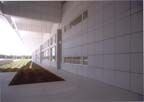
When renowned architect Richard Meier was asked by New York Newsday to name his favorite projects, he chose the U.S. Courthouse and Federal Building in Central Islip, Long Island, NY, as one of them. The project carries Meier's signature style, with an exterior curtainwall of San Sebastian granite from Canada.
The stone was supplied by Polycor Granite Bussière, and there were a variety of factors involved in the selection. “There are many different reasons why a world-class architect like Richard Meier would choose San Sebastian,†said Clermont Perron of Polycor Granite Bussière. “The first is the beauty of San Sebastian. This gray, white and black granite has been described as noble, discreet, sophisticated and one with nature.â€
Another reason that the San Sebastian was chosen was because of its uniformity. The large size of the panels needed a consistent look that would not change drastically from the first panel to the last.
Overall, the project required 43,000 square feet of 40- x 40- x 1 5â„8-inch exterior panels; 90,000 square feet of 40- x 40- x 3â„4-inch interior wall panels and 110,000 square feet of 24- x 12- x 3â„4-inch exterior pavers. But despite the large quantities required for the project, Polycor Granite Bussière was confident that it was up to the task. “The San Sebastian quarry has the capacity to supply large demands, and it is a very reliable quarry,†Perron explained.
In addition to the materials aesthetic and practical qualities, the location of the quarry played a key part in the selection process, as North American materials are generally requested for government buildings. The fact that the San Sebastian quarry was also relatively close to the construction site was also a plus.
To complete the project, Richard Meier & Partners, Architects LLP, worked with the Spector Group, and Turner Construction served as the general contractor.
Making an impact
The San Sebastian granite facade is one of the first features visitors and residents see, as the courthouse is positioned to take advantage of the area's panoramic views to the Great South Bay and Atlantic Ocean beyond. The building rests on a raised plaza which functions as a “place†delineator, marking the bounds of the federal building and inviting occupation by means of low walls and stairs. A cone-shaped, top-lit rotunda is a plaza focal point, and the nine-story-high entrance lends civic stature.In contrast to the plaza facade, the north facade is designed in a closed manner, which is appropriate to the expression of the more secure functions contained within that area of the building.
Once inside, visitors pass through security screening to a 12-story atrium in the main block of the courthouse. The atrium is a space of orientation to the courts, library and offices, dividing the District Court functions to the west from the Bankruptcy Court functions to the east.
The main rectangular volume, which contains the complex's administrative and judicial services and courtrooms, allows enough flexibility to accommodate expansion through a projected 30-year period.
The project has received accolades from various sources. The U.S. General Services Administration awarded its 2001 Architectural Award, with the jury stating that the courthouse “has the visual intelligence of the finest contemporary architecture; yet it embodies the genetic code of significant historical buildings.â€
The American Institute of Architects also awarded the project, bestowing it with its 2003 Honor Award. “The classic modernist articulation of this building creates a proud and regal form without relying on old emblems of the archetypal courthouse,†stated the jury. “The arrangement also allows for the social ideology and the public nature of our system of law to be expressed in built form.â€
For Polycor Granite Bussière, the U.S. Courthouse and Federal Building was an opportunity for the company to showcase its skills as a supplier for high-profile buildings. “This project has created a reputation in stone for us because of our involvement in its success,†said Perron. “It is always a privilege to work with legends like Richard Meier.â€